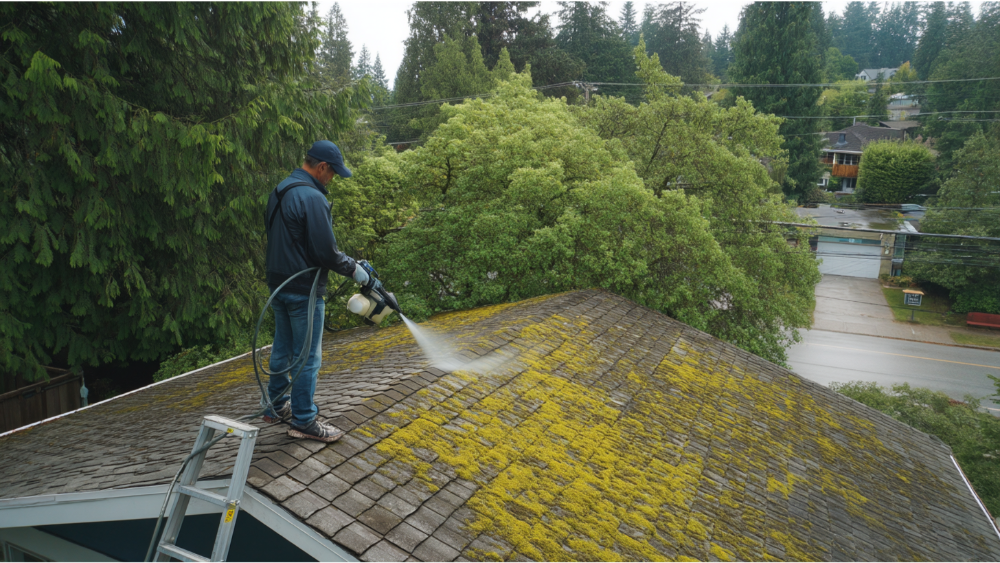Everything You Need to Know About Roof Moss, Moss Removal, and Long-Term Prevention
A moss covered roof may look charming, but what it’s doing to your shingles and your home’s structural integrity is far from harmless. Roof moss retains moisture, compromises roofing materials, and can lead to mold growth, wood rot, and premature aging of your entire roofing system. That’s why knowing how to remove moss from roof surfaces, and how to prevent moss from coming back, is critical for protecting your investment.
At Cobex Construction Group, we specialize in helping Northern California homeowners maintain strong, moss free roofs with proven moss removal strategies, expert craftsmanship, and long-term prevention solutions. This guide walks you through every step, whether you’re dealing with minor moss growth or roofs completely covered in thick, spindly moss.
Why Roof Moss Is a Bigger Threat Than You Think
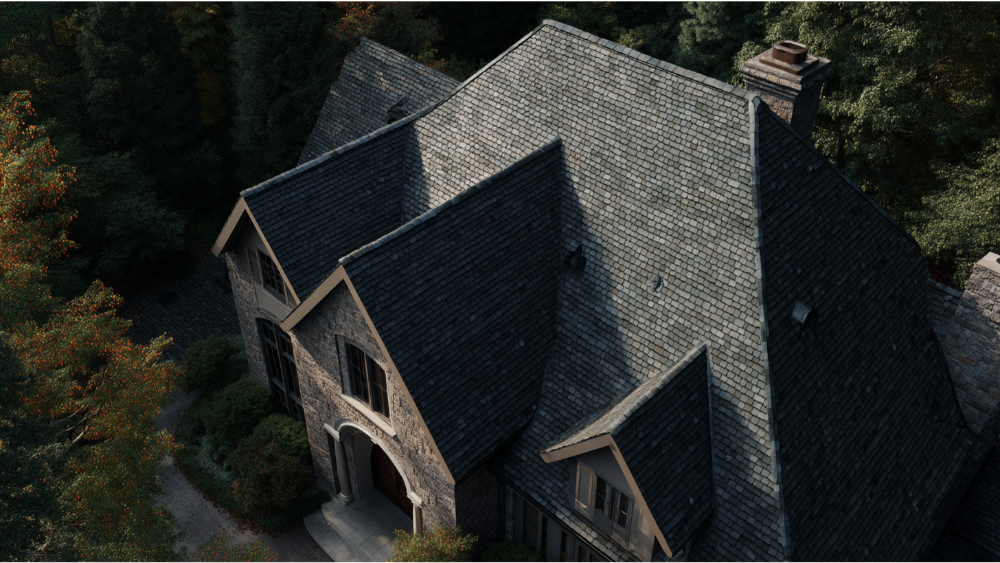
Roof Moss Causes Serious Structural Problems
When moss grows on asphalt shingles or roof tiles, it traps rain water against your roof. Over time, this constant moisture leads to wood rot beneath your shingles and causes pre mature aging of your roofing materials. Roof moss also damages the protective granules on shingles, reducing their lifespan and making your roof vulnerable to wind damage and leaks.
Moss Accumulation Blocks Drainage Systems
Moss growth often spreads to your gutter system, where it can quickly block downspouts and disrupt your underground drainage system. Loose moss and excess debris can also clog valleys and flashing, leaving your roof vulnerable to water pooling and long-term structural deterioration.
Moss Harms Your Home’s Energy Efficiency
As moss lifts shingles and creates gaps, it allows heat and conditioned air to escape. This disrupts insulation and increases your energy bills year-round. Plus, the moisture from a moss covered roof contributes to a breeding ground for mold growth inside attics and walls.
How to Remove Moss from Roof Surfaces Safely and Effectively
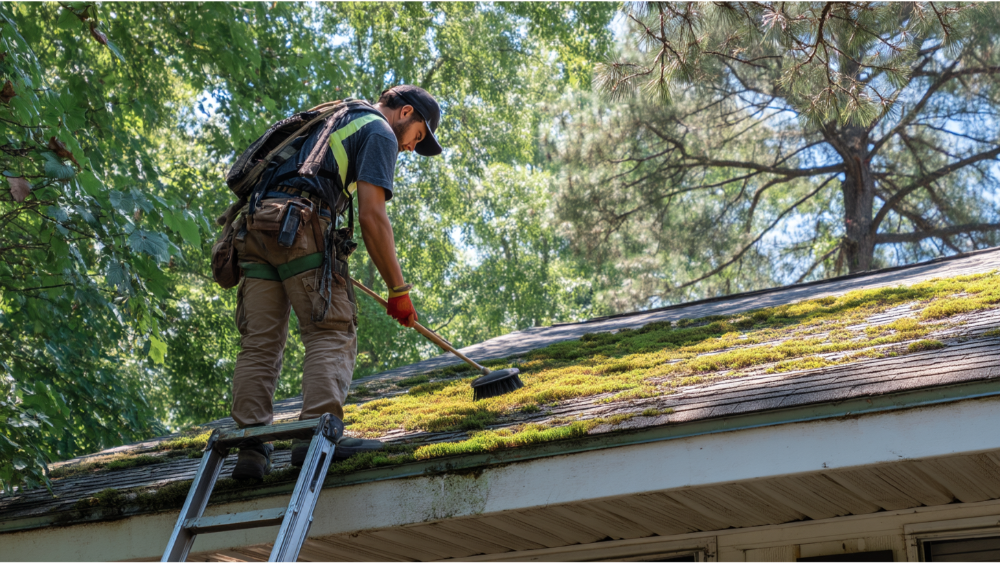
Step 1: Apply a Moss Killer Solution
The first step in the moss removal process is applying an effective moss killer solution. You can choose a commercial moss killer specifically designed for roofs or make a DIY treatment using common ingredients like dish soap, bleach, or vinegar. Apply the moss killer using a pump sprayer or a hose end sprayer, depending on the size of your roof and accessibility.
Popular Options:
- 50/50 bleach and water mix with a few drops of dish soap
- Granulated zinc sulfate applied during dry conditions
- SH kill roof moss mix (Sodium Hypochlorite or “hot SH mix”)
Let the moss killer soak into the moss for 15 to 30 minutes. Avoid rinsing too early, the solution needs time to break down the moss structure.
Step 2: Wait for the Moss to Die and Dry Out
After application, wait one to two weeks for the moss to die. You’ll know the treatment worked when you see dead and dried moss turning brown or gray. Moss dies gradually, and depending on weather conditions, some thicker patches may take longer to break down.
Important: Not all moss dies at the same rate, and larger clumpy moss may require a second application of your moss killer.
Step 3: Brush Moss Gently Off the Roof
Once you have dead and dried moss, it’s time to brush moss off your roofing materials. Use a soft wire brush or a broom with soft bristles to gently dislodge large clumps of moss. Always brush downward to avoid lifting shingles and damaging your roof.
Never use a pressure washer or aggressive scrubbing tools. Pressure washing may seem effective but can damage roofs by stripping off protective granules and forcing water underneath the shingles.
Step 4: Remove Loose Debris and Clean Up
Next, remove loose debris like twigs, leaves, and loose moss with a leaf blower or broom. A gas powered leaf blower is especially effective for large rooftops with steep slopes. Be sure to clean out your gutters and downspouts after brushing to prevent clogs.
If any remaining moss structure or stains are left behind, use a garden hose on low pressure to rinse the area. In some cases, a second application of moss killer solution may be necessary to remove remaining stains completely.
When to Leave Moss Intact and Call a Professional
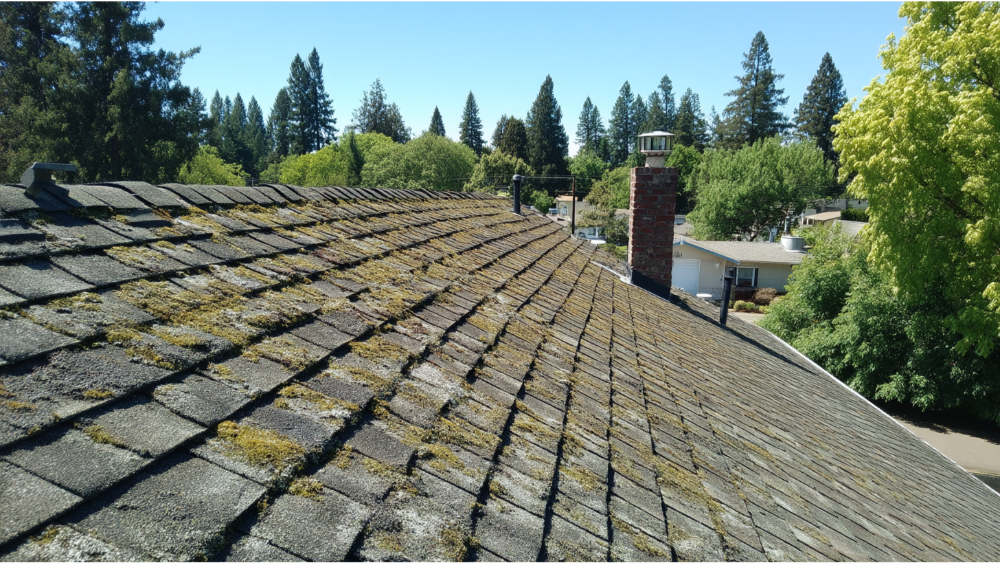
Some homeowners are tempted to leave moss intact, especially if it looks minor or is only in one section of the roof. But even minor moss growth can spread rapidly in damp conditions and cause significant damage in just one season.
If your roof is steep, high, or covered with delicate roofing materials, or if you have any concerns about safety, it’s best to contact a roofing professional. At Cobex, we prioritize customer’s roof safety with proper fall protection, soft wash approach cleaning, and warranty-backed work.
The Best Long-Term Ways to Prevent Moss Growth on Your Roof
Install Zinc or Copper Strips
To prevent moss from regrowing, install zinc or copper strips along the ridge of your roof. As rain water washes over the metal, it releases ions that inhibit moss growth naturally. These strips can last for years and are one of the most cost-effective long-term solutions to keep your roof moss free.
Keep the Roof Clear of Organic Debris
Overhanging branches, pine needles, and leaves create ideal conditions where moss thrives. Trim back trees, remove loose debris regularly, and schedule roof cleaning services at least once per year. Moss growth thrives in cool, shaded, and moist environments, so increasing sunlight exposure can significantly prevent moss.
Improve Roof Ventilation and Drainage
Proper attic ventilation reduces moisture buildup, which helps inhibit moss growth from the inside out. Make sure your ventilation system is functioning properly, and inspect your gutter system to ensure rain water flows away from the home efficiently.
Use Preventative Chemical Treatments Annually
An annual preventative chemical treatment using zinc sulfate, granulated zinc sulfate, or a diluted SH kill roof moss mix can stop moss before it starts. These treatments are ideal for homes in the Pacific North West or Northern California where rainfall and shade are common.
For the best results, have Cobex treat roof surfaces annually to ensure full moss prevention without risking damage to your shingle roof or surrounding landscaping.
Should You DIY or Hire a Professional for Roof Moss Removal?
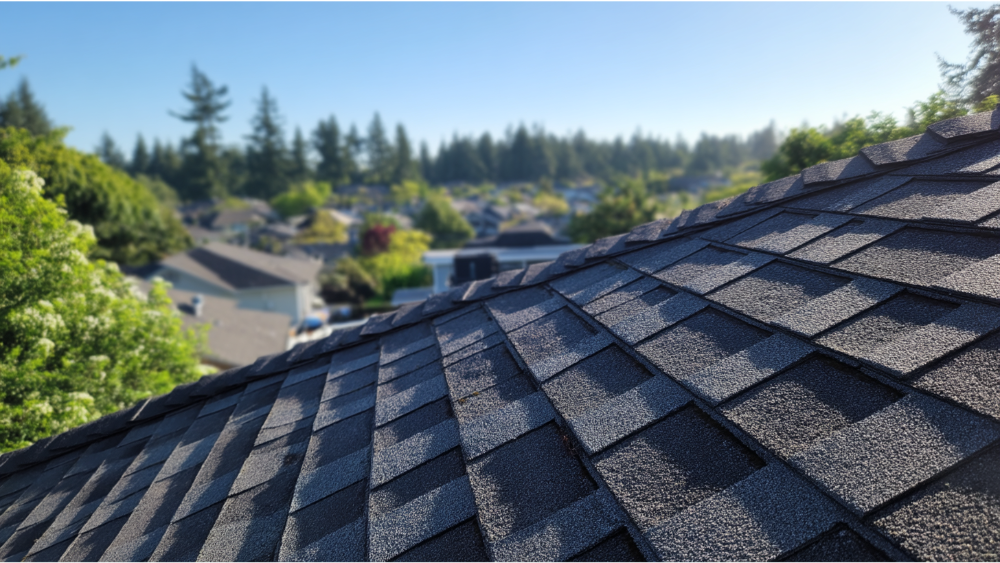
When DIY Makes Sense
If you have a single-story home with a low-slope roof and minor moss growth, you may be able to safely remove moss yourself using a moss killer, spray bottle or pump sprayer, and brush. Just make sure you have proper fall protection and avoid damage by using only approved tools like soft wire brushes and leaf blowers.
When to Call in the Experts
If your roof is difficult to access, roofs completely covered in thick moss, or you need to remove moss from delicate or older roofing materials, it’s time to call in the pros. Our team uses the safest soft wash approach, avoids pressure washing, and ensures complete removal of moss, stains, and debris.
Remember: DIY moss removal might save a few dollars up front but risks costly roof damage if done incorrectly.
Frequently Asked How To Remove Moss From Roof Questions
What time of year should I treat moss on my roof?
Late spring and early fall are ideal times for moss removal in Northern California. Dry weather helps the moss killer solution soak in and lets the moss dry out quickly.
Are moss-killing chemicals safe around pets and plants?
Many moss killers are safe when used as directed, but it’s smart to cover nearby plants during application and rinse thoroughly after treatment. Always follow product safety labels.
Will moss void my roofing warranty?
Yes. Allowing moss to grow unchecked can be considered neglect, which may void warranties on asphalt shingles and other roofing materials. Regular roof cleaning protects your investment.
How often should I treat my roof for moss?
At least once per year, or more frequently if you live in a damp, shaded area like the Pacific North West. Annual treatment helps prevent moss growth and extends your roof’s lifespan.
What’s the best moss killer for residential roofs?
Look for an excellent moss killer with sodium hypochlorite or zinc sulfate designed for roofing use. Avoid household cleaners not labeled safe for roof applications.
Keep Your Roof Strong and Moss Free with Cobex
Roof moss is more than a cosmetic issue. It’s a slow-moving but serious threat to your roof’s performance, structure, and longevity. Fortunately, with regular maintenance, annual treatment, and the right preventative tools like zinc or copper strips and proper drainage, you can keep your roof in excellent shape year-round.
At Cobex Construction Group, we help homeowners across Northern California remove moss safely, clean their roofs without damage, and prevent moss from returning. Whether you’re ready to book a full roof cleaning or just want a second opinion, we’re here to help.
Ready to protect your roof for the long haul? Contact Cobex today for expert moss removal, roof cleaning, and long-lasting prevention solutions.
